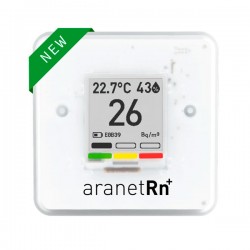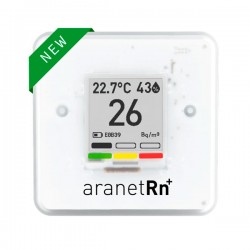No products
Prices are tax excluded
New products
-

Submersible Temperature Data Logger – Tinytag Aquatic 2 TG-4100
Tinytag Aquatic 2 TG-4100 – Submersible Temperature Data Logger Robust...
228,00€ -

-

Datalogger USB de Temperatura e Humidade EasyLog EL-USB-2-LCD+
EasyLog EL-USB-2-LCD+ – USB Temperature & Humidity Data Logger...
118,50€ -

Earth Ground Resistance Tester PCE-ERT 10
Earth Ground Resistance Tester PCE-ERT 10 The PCE-ERT 10 Ground...
198,90€ -

Handheld Vibration Meter PCE-VT 1100
Handheld Vibration Meter The PCE-VT 1100 handheld vibration meter is a...
291,90€ -

Energy Monitoring Module with Ethernet, Modbus Gateway and Data Logger - TCW260
Energy Monitoring Module The TCW260 is a high-performance energy...
283,70€ -

Ultrasonic Material Thickness Gauge Elcometer MTG8-TXC
Material Thickness Gauge The Elcometer MTG Ultrasonic Thickness Gauges...
2 449,00€ -

Sound Level Meter PCE-MSL 1
Product Description The PCE-MSL 1 sound level meter is a compact and...
36,90€ -

4G LTE Wireless I/O Module with MQTT - TCG120-4G
4G LTE Wireless I/O Module with MQTT Support The TCG120-4 is an...
269,70€ -

Industrial IoT module TCW242
Smart Ethernet controller for industrial automation The Industrial IoT...
225,10€ -

Ultrasonic Material Thickness Gauge Elcometer MTG6-TXC
Material Thickness Gauge The Elcometer MTG Ultrasonic Thickness Gauges...
1 930,00€ -

Particle Counter PCE-RCM 12
Product overview – PCE-RCM 12 particle counter The PCE-RCM 12 particle...
466,90€ -

Particle Meter PCE-RCM 02
Product Description The PCE-RCM 02 Particle Meter is an advanced,...
131,90€ -

Elcometer MTG Ultrasonic Material Thickness Gauge MTG2-TXC
Material Thickness Gauges The Elcometer MTG range delivers fast,...
1 126,00€ -

Mini Anemometer PCE-MAM 2
Product Overview The PCE-MAM 2 pocket-size mini anemometer delivers...
38,90€ -

Mini Thermo-Hygrometer PCE-444
Product Description The PCE-444 Mini Thermo-Hygrometer is a compact and...
38,90€ -

Infrared Thermometer - ScanTemp 355
Overview The ScanTemp 355 adds a circle laser sight and lets you read...
42,00€ -

Infrared Thermometer PCE-889B
Overview The PCE-889B infrared thermometer delivers fast, non-contact...
160,90€ -

Reliable IP Monitoring & Control for Sensors and I/O Poseidon2 3268
Poseidon2 3268 — Reliable IP Monitoring & Control for Sensors and...
458,70€ -

Temperature & Humidity Transmitter 4–20 mA — Ref. T3110
Temperature & Humidity Transmitter The T3110 is a temperature and...
225,00€ -

Ultrasonic Material Thickness Gauge Elcometer MTG4-TXC
Material Thickness Gauge The Elcometer MTG Ultrasonic Thickness Gauges...
1 450,00€ -

Stainless Steel Bench Scale 6 Kg — Ref.: FOB 6K2
Description The compact stainless steel bench scale with color-guided...
240,00€ -

Wall-Mount Temperature & Humidity Sensor HTemp-1Wire-Box2 | HW Group
HTemp-1Wire-Box2 Temperature & Humidity Sensor The HTemp-1Wire-Box2...
130,90€ -

Environmental gateway with LTE TDSBOB03
3-in-1 environmental gateway with LTE, PoE and IP67 The Aranet PRO Plus...
560,00€ -

Precision Balance 60 g | 440-21A
The 440-21A precision balance delivers fast, reliable weighing up to 60...
380,00€ -

Professional SNMP Device for Remote Environment Monitoring STE2 PLUS | HW Group
STE2 PLUS — Professional SNMP Thermometer for Remote Environment...
349,00€ -

Infrared Food Thermometer PCE-IR 100 (HACCP)
Description The PCE-IR 100 combines fast, hygienic non-contact infrared...
89,90€ -

Thermal Environment Meter PCE-WB 20SD
Overview The PCE-WB 20SD is a data-logging thermal environment meter...
560,90€ -

Thermal Environment Meter – PCE-WBGT 10
Thermal Environment Meter The PCE-WBGT 10 Thermal Environment Meter is...
137,90€ -

Data Logger with Display for Temperature, Humidity, Dew Point and Pressure
LOG220 PDF – Data Logger with Display for Temperature, Humidity, Dew...
97,00€ -

Environmental Meter — 5-in-1 PCE-EM 883
5 environmental parameters Sound level meter | Lux meter | Anemometer |...
222,90€ -

LAN & Wi-Fi Thermometer for Remote Monitoring | STE2 R2 — HW group
STE2 R2 — LAN & Wi-Fi Thermometer for Remote Monitoring STE2 R2...
294,00€ -

WiFi Remote Temperature Sensor with External Thermocouple – 21CFR
EL-WiFi-21CFR-TC | EasyLog The EL-WiFi-21CFR-TC is an advanced...
227,50€ -

Temperature and Humidity Mini Sensor TDSPT101
Aranet T/RH Mini Sensor Product Code: TDSPT101 Compact, wireless sensor...
80,00€ -

Digital Force Gauge PCE-FM 200
Tension and Compression Measurement up to 200 N The PCE-FM 200 digital...
351,90€ -

-

Oxygen Content in Liquids PCE-DOM 10
PCE-DOM 10 Water Analyzer The PCE-DOM 10 Water Analyzer is a...
284,90€ -

Professional Oven Thermometer with Flexible Metal Probe 14.1037
Key Features Accurate monitoring of cooking chamber temperature up to...
28,00€ -

Multilogger M1220 – Thermo-Hygrometer with 4 Inputs
Product Overview The Multilogger M1220 is a versatile universal...
765,00€ -

Aranet Radon Plus PRO – Advanced Indoor Air Quality Monitoring Radon Plus PRO TDSPSR02
Advanced Radon Indoor Air Quality Monitoring The Radon Plus PRO delivers...
249,00€ -

Temperature and Humidity Data Logger with Display LOG210 TC PDF
LOG210 TC PDF - Temperature and Humidity Data Logger The LOG210 TC PDF...
103,00€ -

Digital Refractometer for Alcohol Industry ORL 94AL
Digital Refractometer Specialized applications in the Alcohol Industry....
1 040,00€ -

Water Activity Meter PCE-WAT 10 Aw
Description The PCE-WAT 10 Water Activity Meter is a powerful device...
979,90€ -

Colour Spectrometer JCS 200
Versatile Colour Spectrometer for Professional Use The JCS 200 is a...
1 950,00€ -

Luxmeter with External Sensor SO 200K
High-Precision Luxmeter for Light Measurement up to 200,000 Lux The SO...
84,00€ -

-

Aranet 4xT-Probe Sensor TDSPT508
Accurate Multi-Point Temperature Monitoring The Aranet 4xT-Probe Sensor...
490,00€ -

Precision Thermometer LDT-450
Precision Thermometer Precision Thermometer LDT 450 — accurate and...
1 156,52€ -

CO2 Monitor with Built-in Carbon Dioxide Sensor - U8415
U8415 CO2 Monitor with Built-in Carbon Dioxide Sensor The U8415 CO2...
265,00€ -

Pt100 Temperature Immersion Probe Class 1/10 DIN | 6000-1084
Immersion Temperature Probe Explore the premium immersion probe designed...
210,00€ -

Precision Temperature Instrument T995
Precision Temperature Instrument The Series T900 process-controlled...
1 100,00€ -

Precision 4-Wire Pt100 Insertion Temperature Probe AX111-I3-B-150-L01-P-M12
Precision Insertion Temperature Probe The AX 111-I3-B-150-L01-P-M12...
61,00€
EMI, LDA, Edifício Estoril Office, Av. República 3000A, Esc. 19A, 2649-517 Alcabideche PORTUGAL
Radon
Radon is a naturally occurring radioactive gas that is colorless and odorless. Its presence in the environment is common, both outdoors and indoors. However, prolonged exposure to radon inside buildings poses a significant risk to public health.
Inhalation of radon is the primary source of ionizing radiation exposure for the general popula...
Radon
Radon is a naturally occurring radioactive gas that is colorless and odorless. Its presence in the environment is common, both outdoors and indoors. However, prolonged exposure to radon inside buildings poses a significant risk to public health.
Inhalation of radon is the primary source of ionizing radiation exposure for the general population, contributing over 40% to the annual effective dose of radiation received. The percentage of the annual dose received by the global population can be found in the report "Sources and Effects of Ionizing Radiation, UNSCEAR 2008 Report, Vol. I."
Exposure and Health Effects
Prolonged exposure to radon indoors is one of the leading causes of lung cancer. Smokers and ex-smokers are at an increased risk due to the combined action of tobacco and radon. There is no consistent evidence linking radon exposure to other types of cancer or diseases.
Radon produces radioactive particles in the air we breathe. These particles become trapped in our respiratory pathways, where they emit radiation, causing damage to the lungs. This damage increases the risk of lung cancer with prolonged exposure over time.
According to the World Health Organization (WHO), it is estimated that radon exposure causes between 3% and 14% of lung cancer cases globally. In Europe, it is estimated that 9% of lung cancer deaths are attributed to radon exposure, representing about 2% of all cancer-related deaths.
Radon is present everywhere, both outdoors and indoors in buildings. All buildings contain radon, and in most cases, the concentrations are low.
In Portugal, certain areas of the country are more prone to higher levels of radon in buildings. These areas can be consulted on the radon susceptibility map. The map, produced from a national survey and the national radon monitoring campaign, indicates the level of susceptibility to radon indoors. However, the only way to know the exact radon concentration is by direct measurement.
Radon Presence and Monitoring
Although radon is present both outdoors and indoors in buildings, its concentration can vary significantly. Most buildings have low concentrations, but there are specific geographic areas where radon levels may be higher.
The only way to determine the exact radon concentration in a building is through direct measurements.
Mitigation of Radon Exposure
Reducing exposure to radon indoors can be achieved through preventive measures implemented during the construction phase of new buildings or through corrective or remediation measures in existing buildings.
Radon There are 2 products.
Aranet Radon Plus PRO – Advanced Indoor...
Advanced Radon Indoor Air Quality Monitoring The Radon Plus PRO delivers real-time measurements of radon gas concentration, temperature, and relative humidity, ensuring accurate monitoring of critical indoor air quality parameters.
249,00€Aranet Radon sensor Aranet Radon Plus PRO...
Brand: Aranet Radon Plus PRO – Advanced Indoor Air Quality Monitoring The Radon Plus PRO enables real-time measurement of radon gas concentration, temperature, and relative humidity. With a portable design, multi-year battery life, and cutting-edge technology, this device ensures convenience and reliability for continuous indoor air quality monitoring.
249,00€



